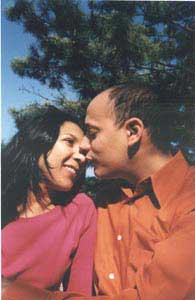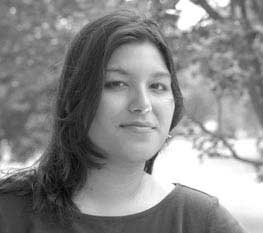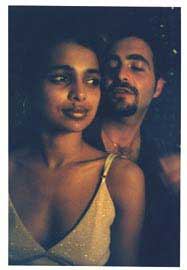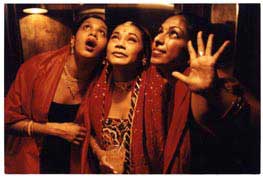Life
Single In The City

They are not married and frankly, my dear, they don't give a damn.
|
They’re in their late 20’s or 30-something, sometimes even early 40’s.
They’re not married and frankly, my dear, they don’t give a damn. Or even if they do, they’re not showing it or letting it get them down. While Indian weddings are held just about every weekend across America, a sizable pool of Indian Americans, especially women, are opting to stay single into their thirties. Between graduate school, long hours at the desk and high-pressure jobs, between activism, art and working out at the gym, between the media onslaught, the Internet, the emails floating around like snowflakes, keeping up with friends and the reality shows on TV, who even has time to think, leave alone search for a soul mate and get married! A decade or two ago, these singles would have been double, triple or even quadruple – with the mandatory spouse and two or three juniors in tow, agonizing about what to cook for dinner or how to fix the baby’s colic. Life was all about graduating to marriage and motherhood. Now singles, both male and female, tend to be more self-absorbed, independent and living on their own and for them, marriage is no longer the be all and the end all of life. The new desi singles are a breed that seems to be getting married or making commitments later and later. In a way this echoes nationwide trends in the United States where the average age of couples at first marriage has grown dramatically.
According to studies conducted by the National Marriage Project, an initiative at Rutgers University, “marriage trends in the U.S. in recent decades indicate that Americans have become less likely to marry, and that fewer of those who do may have marriages they consider to be ‘very happy.'” It cites a decline by one third between 1970 to 2001 in the marriage rate among unmarried adult women. The median age at first marriage went from 20 for females and 23 for males in 1960 to about 25 and 27, respectively, in recent years. Among other factors responsible for the decline, the report said, was “the growth of unmarried co-habitation and a small decrease in the tendency of divorced persons to remarry.” Indian Americans, as part of the larger American population, hreflect these trends, although one can only speculate to what degree. But surely, this trend has to be agonizing for Indian parents. After all, marriage is the very anchor, bulwark and the raison d’etre of all Indian social life; it is what defines people in the desi scheme of things. Some parents start hoarding jewelry for a baby girl when she is born and of course, weddings are the most important occasion of Indian life. Most parents feel they have failed in their duties to their offspring if they don’t see them suitably settled in marriage. They have everything in place, the guest list all organized and all the details worked out – but where is one half of the bridal couple? “The reason why people are getting married later in the Indian community is basically the same as why they’re doing it in the Euro-American community,” says Dr. Sangeeta Gupta, who received her Ph.D. from University of California at Los Angeles and whose research includes cross-cultural issues and immigrant family dynamics. “And that’s because women are working, they’ve got careers and they are trying to find partners on their own – that’s their preference. Realize also that Indian American women are the most educated group of women in this country so as they are going to graduate school that also delays marriage to a large part.”
Many other complex reasons are also responsible for Indian women delaying marriage – and one of the most fundamental is finding a person who not only fits their own criteria but also that of their parents. Says Gupta: “Indian parents would prefer to make the choice for their children, but they don’t realize that that no longer applies to the generation of Indian Americans that we have who are currently of marriageable age. More than 90 percent of them reject the arranged marriage system.” She recalled the case of a 34-year-old woman who’s been in a live-in relationship with her American boyfriend for 14 years: “Her parents won’t even speak to her partner – they hrefuse to meet him. The couple is now getting married next year.” While such extreme cases are rare, parental opposition is often a stumbling block to marriage. During her research, Gupta found that when the children were in their 20’s, parents were often very specific in that they wanted them to marry not only someone who was Indian, but also from their community and caste. Sometimes the children went along and tried it and were introduced to people, sometimes they’d hrefused. Other times it just didn’t work out, and children delayed marriage, citing careers or school. Indeed, most young Indian Americans don’t care about caste and it just tends to narrows the field. Once the children start hitting the late 20’s and 30’s, the parents start loosening their criteria. As one father whose daughter is now in her early 40’s and unmarried, said, “We just wanted her to marry an Indian, but now I don’t care whom she marries.”
Says Gupta, “So Indians are no different from any other group. The problem is that there is a very small number of Indians in this country, even though we’ve reached a good percentage point. When you think of a population of 2 million versus a population of 300 million, it’s a small group. So you’ve got the logistics against you.” Not enough people are within that pool so it makes it difficult to find someone from the same community and when age and education are factored in, it’s even harder. “Having just come off a summer where I attended eight weddings, I don’t know if it’s necessarily that people aren’t getting married,” says S. Mitra Kalita, 27, a reporter with the Washington Post who grew up in this country although she has visited India several times. “The majority of the Indian weddings I went to were ones where they were marrying white Americans, and I have a large number of female Indian friends in their mid to early 30’s. It’s not that they don’t want to get married, but they can’t find the right person. I am sort of starting to count myself in that group.” Although Kalita doesn’t speak for a whole generation, she thinks that her story might be echoed in the lives of many young women who have put their careers first. “My mother came to follow my father and I think her dream was that her daughter would not have to follow anybody, that her daughter would make it on her own. So I grew up very much with the message: study hard and be successful. My mother would tell people that her daughter can’t cook, but she can read lots of books. So it became this mantra she was very proud of.” Once Kalita hit 26, and began a upward climb professionally, her mother’s attitude changed: “She sees the weddings going on, and really wishes her daughter were a part of that. Like many mothers, she wonders if she should have emphasized independence so much, and not the domestic side as well. I think the message earlier was ‘You do whatever you want,’ but except after 25, now the message is ‘Do whatever you want as long as you get married – please!”
Unlike men, women have the nettlesome biological clock to deal with and if they have goals in life or aspire to certain heights in their career then they are really not left with a lot of time. Says Kalita: “There are a lot of Indian women out there who are doing amazing things and we, like our western counterparts, are grappling with wanting everything. We want to have a successful career, we want to have a man who supports us, and we want to have a family life that’s stable and balanced. “I think what’s different with Indian women is that we also have a whole lot of parental pressure to get married and we also have the outlets available to us, like online dating, matrimonial websites and arranged introductions.” Parents keep pushing suitable candidates forward and then wonder why their children don’t like them. Says Gupta: “But what Indian Americans are looking for is some kind of chemistry; they want a different type of relationship based on companionship and love. They reject the premise that love comes after marriage. The fact of not accepting arranged marriage has more to do with being brought up in this culture, maybe seeing the marriages of their parents’ generation, and also wanting the idealized love marriage that you see in Hindi movies all the time.” Some marriages that do take place are undone by patriarchal attitudes where there is no common meeting ground. Are a lot of young Indians singles again because of divorce? Gupta, who won the Cary McWilliams Award for her research on divorce among Indian American women, says that the last census data showed that Indian Americans were getting divorced at a higher rate than their parents: “The divorce rate is rising so you will see more singles in their late 30’s and early 40’s.” She finds age discrimination too working against women: “It’s OK for a man to be looking for a partner in his mid and late 30’s but if the girl is in her late 30’s she’s got to marry someone in his early 40’s or at least few years older than her. Parents are not going to arrange something like that – they are still at the point where they are matching horoscopes!” There aren’t enough Indians in the pool.
Kalita agrees that Indian American women have it harder than men, because males can go down to India and find somebody and that doesn’t happen with the women. “Every now and then I hear of an eligible Assamese man who lives in New Delhi, and I say, no, I can’t do that. I see a lot of my friends are in the same predicament where we can’t fathom going back to India to get married whereas for our brothers, I think it’s definitely more of an option. We fear being with a man with really traditional Indian values, which wouldn’t fit with the model we grew up with in pretty liberal Indian households.” Myna Mukherjee, 29, who founded a classical dance theater company called Nayika in New York, says that career demands can also derail marriage plans. “Running a theater company is so demanding and it’s a very nomadic lifestyle. I was engaged once, but I realized it’s so hard to do justice to a marriage and run a theater company. There was a lot of pressure to get married. My parents are also very conservative so I’d rather be single and do what I want than be married and then perhaps have to go through divorce. I’ve seen just too many friends go down this route.” While most women would prefer to marry within their own community, love often just happens with someone from across the cultural divide. Safia Fatimi, 30, is a successful commercial photographer who’s done shoots for Sony Music, Vibe and Glamour and is also embarking on her masters in education at Columbia. Her mother is Nepalese from India and her father is Pakistani, yet when she herself got married two years ago, it was to someone far from her heritage. It was hard finding South Asian men who were on the same page as her. “It was just that these men didn’t understand what I did and they didn’t take it seriously,” she recalls. “They thought it was a hobby and so it was really hard for me to relate to them. I got to the point I’d become skeptical every time I met someone new. It was also probably my attitude – I’m pretty westernized and I’m not as traditional probably as the guys I met would have liked.” Prerana Reddy, program administrator for the African Film Festival, is 28 and she hasn’t found time for marriage either. She lives with Jawad Metni, her Lebanese boyfriend and finds the situation quite satisfactory. “I wanted to explore my career and do something that was a little unconventional, which is working in arts, non-profits, and doing freelance work,” she says. “The hours were crazy and the job security was non-existent so I needed to spend more time toward what was important to me. It is hard to think of marriage when you have that kind of focus.” The daughter of liberal parents, she never felt the pressure to conform. Her mother had been married and divorced as a young girl and because of that traumatic experience has never pushed Reddy to rush into a hasty marriage. “My parents have been here 26 years and they would never insist on me finding someone Indian or South Asian. My grandparents probably would, but they are living in India. I’ve been with my boyfriend for nearly five years now and being in New York and in the U.S., you can live together, you can try it out. “It’s a gradual thing, there’s no rush to jump into marriage. There’s no social pressure that marriage is the only thing. We are just allowed to take things slowly and see how things work before we jump into marriage.” She questions the security of marriage, given the number of divorces taking place and feels it’s not much more than the security which already exists when two people make a commitment to each other, without the legality of marriage. “My family who’ve met my partner love him – there’s no issue,” she says. “They see it as a life step and this is a sequence that happens. Grandparents, however, can’t relax until you’re settled and settled means married, even if you’re living with somebody and you’ve had the same job for five years – in their minds, you’re not settled till you are married.” Indeed, most Indian parents have weddings as the primary thought on their minds for their sons or daughters. As Anand, a teacher in New York who did not want to use his real name, observed, “I’m 27, male, never married, and born in Chicago to Telugu parents who have stepped up their marriage-plan inquisition a notch recently.” Even though he grew up in America, the language spoken at home was Telegu; he went to the temple regularly and had his grandparents living in the home. Although he has merged his two worlds, he draws the line at the pressure to tie the knot through arranged introductions. “Part of it is that often people in my position feel uncomfortably pushed and pulled because I have my own script about what I want to do and my parents’ ideas are more traditional, more long term and conservative.” He’s pressurized to meet suitable girls regularly and as he puts it, “It’s kind of awkward, because you’re expected to talk to someone for the first time and think about things that by American standards are very long term.” He also has women friends who are marrying late for some of the same reasons. “It’s not just an economical or social relationship – it’s emotional, it’s personal – they want to marry the right person. It’s the same for men,” says Anand. “For people in my position, there are things which we can do, professionally and academically, that are not dependent on being the patriarch of a family. Post 65 immigrants have a set of values that is not shared by the whole community, that’s where I’m coming from.” He adds, “It’s not necessarily a matter of age, but if you look at it from a traditional mind set, then there’s an age by which you should get married. I personally think people are much more different than that and so you can’t say there’s an age by which everyone should get married.” The process of finding the right person can sometimes be painful, like a root canal, and it’s no surprise that many young women have horror stories to tell. Neera, who declined to give her real name, is in the software business. She said, “The expectations of society and family are changing for women and I think this is a very stressful thing. Women are now expected to not only take care of their homes, their husbands, their kids, but are also expected to be well educated and have ‘respectful’ careers. It gives the in-laws the ability to boast about their daughter-in-law, if she is educated.” She points out that the daughters of new immigrants who come to Canada and the U.S. and are struggling to find their economic footing, get it rougher as the parents want to get them married quickly and not place that much emphasis on education: “We all search for the best package, and we could end up waiting a long time to get that package we are looking for. Those women who have waited beyond the ‘expected’ age to get married, are meeting men their age who end up marrying someone from India, or someone much younger, and this leaves the women to be waiting for quite some time.”
There is also a darker side to some relationships. As Neera describes it, “How are you ever sure if you are with the right person, when your benchmark is of abusive men, telling you what you should do, and not what you want to do. So, we end up going through one bad relationship after another, and then before we know it, we are older and have passed the ‘marriage age.'” For some singles putting off marriage it is figuring out their sexual orientation. Aradhana, not her real name, is bi-sexual and is dating a woman with whom she’s in a very committed relationship. She says, “The idea of stability coming from marriage is changing because the number of divorces is increasing so much, even in the South Asian community, that I think women are realizing that stability can be in many other forms, other than marriage. It’s something that you have to look for within yourself rather than in a partner, although it’s nice to share a life with someone.” And so life goes on: the glossy wedding cards with the auspicious Ganeshas stamped on them keep arriving in the mail, giving the parents of unmarried children a feeling of panic. And the singles rush on in their life of hurry and scurry, seemingly with no time or inclination to give in to their parents’ demands. Indeed, this generation of Indian Americans is looking for something very different from the relationships of their parents’ generation, and that takes time to find. As they move through dating relationships, like the larger population, they are also often finding themselves in agonizing relationships that are falling apart or are just not what they hoped they’d be. And so as they try to connect in a swirl of strangers, finding the right person becomes a challenge, and time moves on. Oh, the beautiful simplicity of the village matchmaker, where the bride and groom had nothing to do but show up for the nuptials! “I think it’s a difficult situation for both sides, for parents and for the younger generation, in the sense the parents really, truly want the children to be happy and the children want the approval and acceptance of their parents,” says Sangeeta Gupta. “The parents have to accept the fact that their children are being raised in a different country, that it was their choice to bring them here and they are not going to do the same thing their parents did. What I would like to see is more dialogue between the two generations, with both really talking and listening to each other.” And in the listening and the talking, mothers and daughters may finally realize that their dreams and desires are not that far apart, and that happiness can come in many different forms. |








You must be logged in to post a comment Login